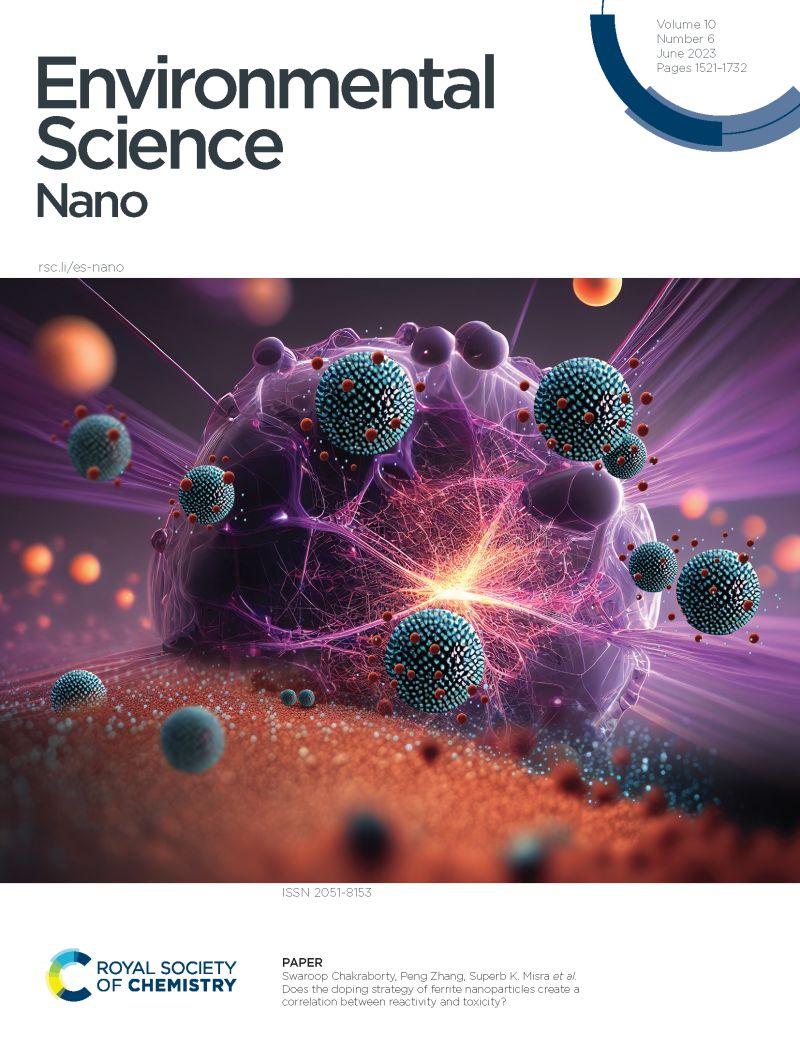Multi-omics revealed the mechanisms of AgNP-priming enhanced rice salinity tolerance
IF 5.8
2区 环境科学与生态学
Q1 CHEMISTRY, MULTIDISCIPLINARY
引用次数: 0
Abstract
Rice is highly susceptible to salt stress. Increasing the salt tolerance of rice is critical to reduce yield loss. Herein, we investigated the possibility of using an AgNP-based priming method (seed soaking (SP) and leaf spraying (LP)) to enhance rice salt tolerance. Under saline conditions, both SP (40 mg L−1) and LP (∼0.15 mg per plant) significantly increased the biomass (10.4–13.4%) and height (6.6–6.9%) of 6-week-old rice seedlings. In addition, SP significantly increased chlorophyll a (7.3%) and carotenoid (7.9%) content as well as total antioxidant capacity (10.5%), whereas it decreased malondialdehyde (MDA) content (16.9%) in rice leaves. These findings indicate that AgNP priming, especially SP, improved the salt tolerance of rice seedlings. A life cycle field study conducted in a real saline land revealed that SP significantly increased the rice grain yield by 25.8% compared to hydropriming. Multi-omics analyses demonstrated that AgNP priming induced metabolic and transcriptional reprogramming in both seeds and leaves. Notably, both SP and LP upregulated osmoprotectants in seeds and leaves. Furthermore, several transcriptional factors (TFs), such as WRKY and NAC, and salt-tolerance related genes, including the high-affinity K+ channel gene (OsHKT2;4, OsHAK5), the Ca2+/proton exchanger (CAX4), and the cation/Ca2+ exchanger (CCX4), were upregulated in leaves. Omics data provide a deep insight into the molecular mechanisms for enhanced salinity tolerance. Together, the results of this study suggest that seed priming with AgNPs can enhance the salt tolerance of rice and increase rice yield in saline soil, which provides an efficient and simple way to engineering salt-tolerant rice.

多组学揭示AgNP-priming增强水稻耐盐性的机制
水稻极易受到盐胁迫的影响。提高水稻的耐盐性对减少产量损失至关重要。在此,我们研究了使用基于 AgNP 的引种方法(浸种(SP)和叶面喷洒(LP))提高水稻耐盐性的可能性。在盐碱条件下,SP(40 mg L-1)和 LP(每株∼0.15 mg)都能显著增加 6 周龄水稻秧苗的生物量(10.4-13.4%)和高度(6.6-6.9%)。此外,SP 还能明显增加水稻叶片中叶绿素 a(7.3%)和类胡萝卜素(7.9%)的含量以及总抗氧化能力(10.5%),同时降低水稻叶片中丙二醛(MDA)的含量(16.9%)。这些研究结果表明,AgNP(尤其是 SP)能提高水稻秧苗的耐盐性。在实际盐碱地进行的生命周期田间研究表明,与水刺相比,SP 能显著提高水稻产量 25.8%。多组学分析表明,AgNP引物诱导了种子和叶片的代谢和转录重编程。值得注意的是,SP 和 LP 都上调了种子和叶片中的渗透保护剂。此外,一些转录因子(TFs),如 WRKY 和 NAC,以及耐盐相关基因,包括高亲和性 K+ 通道基因(OsHKT2;4, OsHAK5)、Ca2+/质子交换子(CAX4)和阳离子/Ca2+交换子(CCX4),都在叶片中上调。Omics 数据深入揭示了耐盐性增强的分子机制。综上所述,本研究的结果表明,用 AgNPs 给种子打底可以增强水稻的耐盐性,提高水稻在盐碱地中的产量,这为耐盐水稻的工程化提供了一种高效而简单的方法。
本文章由计算机程序翻译,如有差异,请以英文原文为准。
求助全文
约1分钟内获得全文
求助全文
来源期刊

Environmental Science: Nano
CHEMISTRY, MULTIDISCIPLINARY-ENVIRONMENTAL SCIENCES
CiteScore
12.20
自引率
5.50%
发文量
290
审稿时长
2.1 months
期刊介绍:
Environmental Science: Nano serves as a comprehensive and high-impact peer-reviewed source of information on the design and demonstration of engineered nanomaterials for environment-based applications. It also covers the interactions between engineered, natural, and incidental nanomaterials with biological and environmental systems. This scope includes, but is not limited to, the following topic areas:
Novel nanomaterial-based applications for water, air, soil, food, and energy sustainability
Nanomaterial interactions with biological systems and nanotoxicology
Environmental fate, reactivity, and transformations of nanoscale materials
Nanoscale processes in the environment
Sustainable nanotechnology including rational nanomaterial design, life cycle assessment, risk/benefit analysis
 求助内容:
求助内容: 应助结果提醒方式:
应助结果提醒方式:


